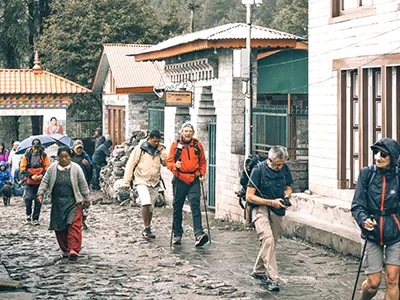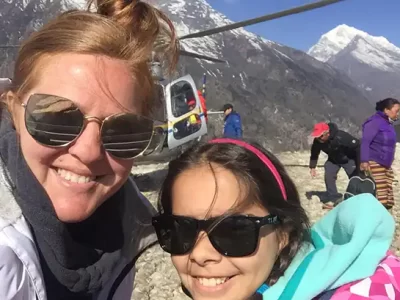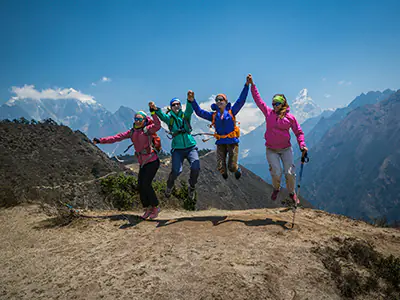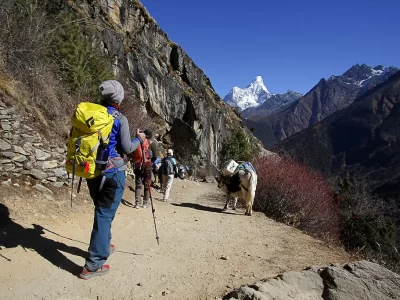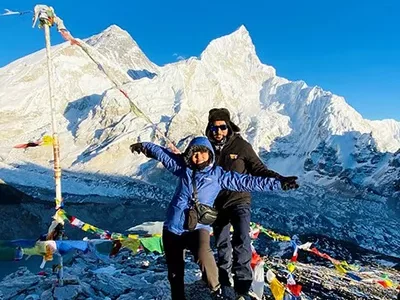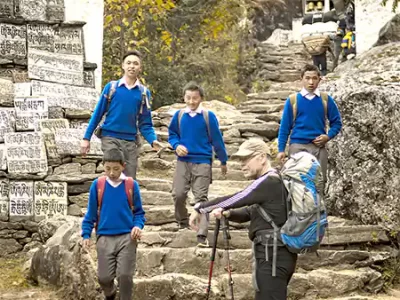Heading to Everest Base Camp in November promises an exciting expedition deep into the Himalayas, offering adventurers a unique opportunity to intimately experience the grandeur of Mount Everest, the world’s highest peak. This renowned trek is a must-do for countless enthusiasts, and November is considered the perfect month to commence this truly breathtaking journey.
Significance of Trekking in November: November brings a unique charm to the Everest region. The crisp and clear weather provides stunning panoramic views of snow-capped peaks. With fewer tourists, the trails are less crowded, allowing for a more tranquil and intimate connection with the natural beauty and local culture. The moderate temperatures in November make it easier to adapt to the altitude, reducing the risk of altitude sickness.
This blog will guide you on a virtual exploration of the Everest Base Camp Trek in November. You can expect to find detailed insights on why November is the perfect time for this trek, a comprehensive itinerary, packing tips for the chilly weather, safety guidelines, and a breakdown of costs. We’ll also share captivating stories of the mesmerizing landscapes, encounters with unique wildlife, and interactions with the resilient Sherpa communities.
Whether you’re a seasoned trekker or a novice adventurer, this guide will provide all the essential information to make your Everest Base Camp Trek in November a memorable and safe experience. Let’s lace up those hiking boots and venture into the awe-inspiring Himalayas together!
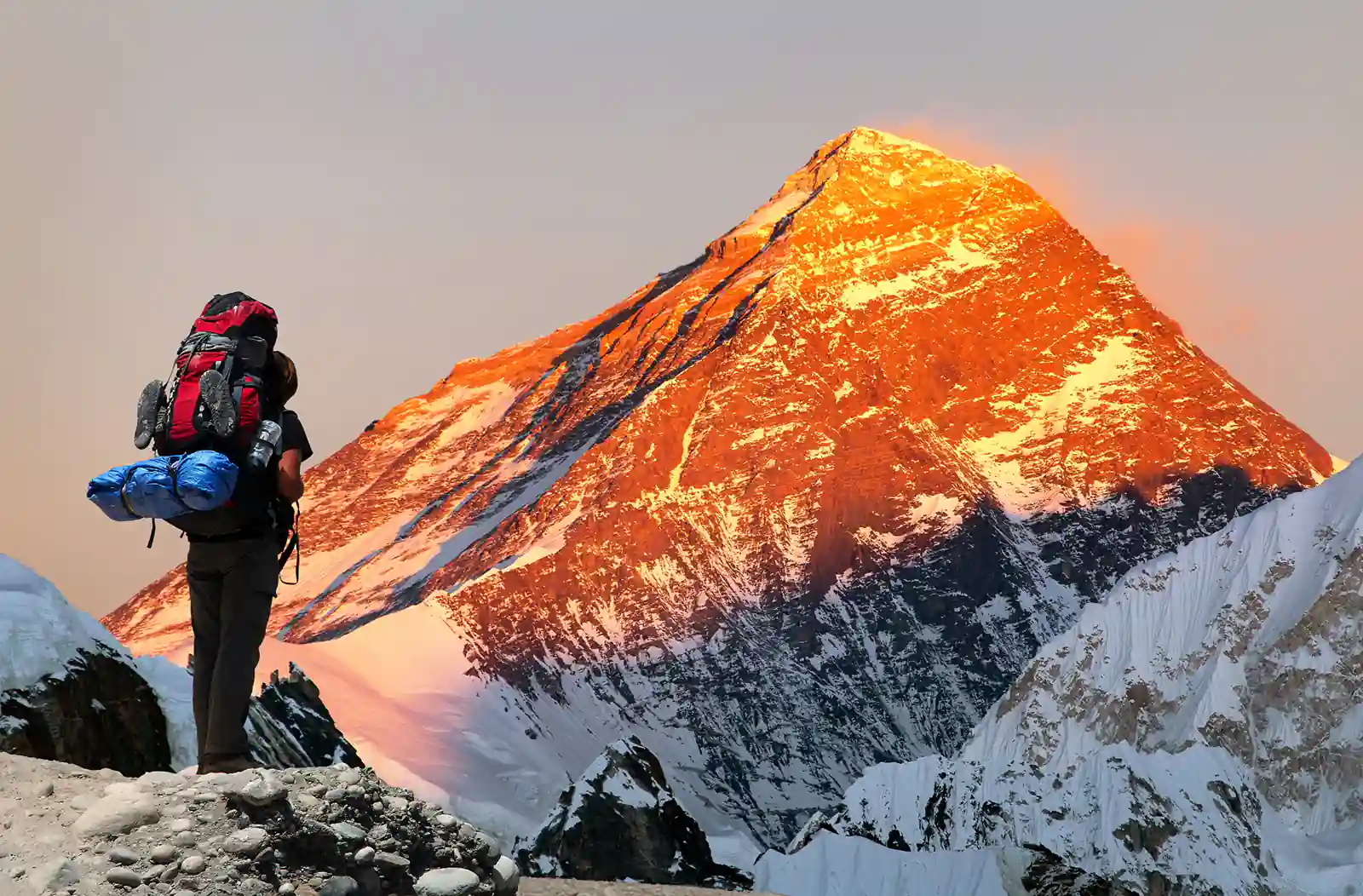
November is Ideal for the Everest Base Camp Trek
Regarding the legendary Everest Base Camp Trek in November, you’re in for an unforgettable adventure. This month is the prime time to undertake this incredible journey for several compelling reasons.
Weather Conditions in November:
In November, the Everest region experiences crisp and stable weather conditions. The monsoon season has passed, leaving behind clear skies and minimal precipitation. Temperatures during the day hover around a comfortable 10 to 15 degrees Celsius (50 to 59 degrees Fahrenheit) at lower elevations, making hiking a delight. Evenings can get cooler, but you’ll stay warm and cosy with the right gear.
November is favored as the optimal time for this trek for several compelling reasons:
November offers an ideal blend of favourable weather and accessibility. The trails are dry and well-trodden, ensuring safe passage through challenging terrain. This month strikes a balance between avoiding the harsh winter cold and the monsoon’s muddy and slippery trails, making it the best compromise for trekking enthusiasts.
Advantages like Clear Skies and Fewer Crowds:
The skies in November are astonishingly clear, granting unobstructed vistas of the towering Himalayan peaks. Furthermore, November sees fewer crowds on the trails compared to the peak trekking season in spring. You’ll have quieter trails, more serene moments, and a better chance to savour the solitude of this pristine wilderness.
November offers the perfect window to experience the Everest Base Camp Trek. With its fantastic weather, comfortable temperatures, and the gift of clear skies and solitude, it’s an opportunity to create cherished memories while basking in the majestic beauty of the Himalayas. So, if you’re contemplating when to take on this epic journey, November should top your list.
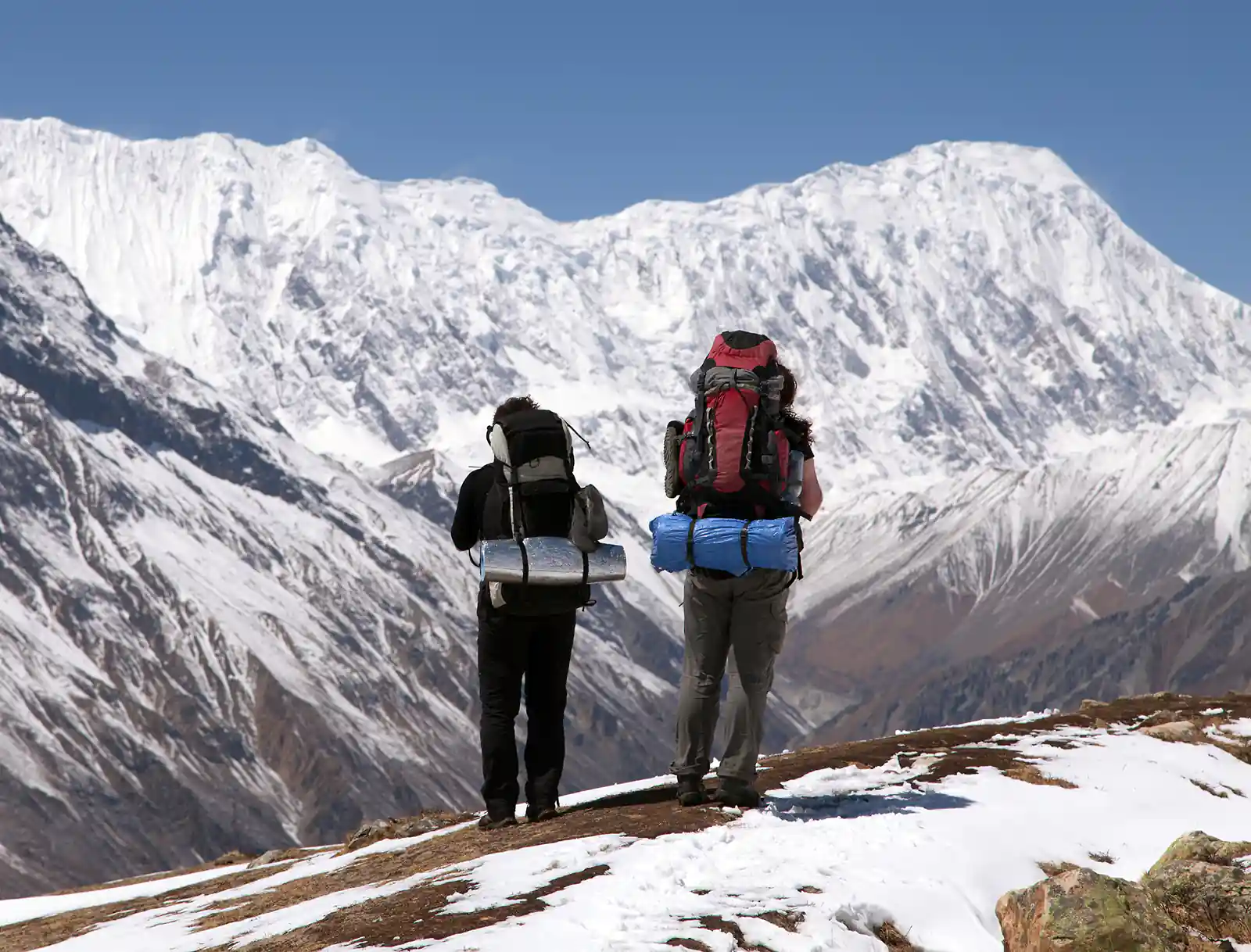
Preparing for the Everest Base Camp Trek in November
Everest Base Camp Trek in November requires meticulous preparation to ensure a safe and enjoyable journey. Here are key aspects to consider:
Packing Essentials for November Trekking:
When packing for a November trek, prioritize warm clothing. Insulated layers, down jackets, thermal wear, and waterproof gear are essential due to cooler temperatures and potential rain or snowfall. Sturdy, waterproof boots with good traction are vital to navigating rocky terrain. Remember essentials like a headlamp, trekking poles, a reliable sleeping bag, and a backpack with proper support.
Physical Fitness and Training Requirements:
Physical preparation is crucial for tackling challenging terrain and high altitudes. Focus on cardiovascular endurance with activities like hiking, jogging, and cycling. Prioritizing strength training for your legs and core is crucial. Acclimatization walks at higher altitudes can also help reduce the risk of altitude sickness. Maintaining several months of regular training is advisable to enhance your stamina and strength.
Permits and Paperwork Needed for the Trek:
Ensure you have the necessary permits before starting the trek. These typically include the Sagarmatha National Park Entry Permit and the TIMS (Trekkers’ Information Management System) card. Additionally, you may need a Khumbu Pasang Lhamu Rural Municipality Entry Permit to access certain areas. Make multiple photocopies of your identification, passport, and permits, storing them separately in case of loss or theft. Carry passport-sized photos for permit applications.
By attending to these aspects, you’ll be well-prepared for the Everest Base Camp Trek in November. Adequate gear, physical conditioning, and proper permits will help you make the most of this incredible adventure, ensuring your safety and comfort as you journey through the stunning Himalayan landscape.
Luxury Everest Base Camp Trek
Everest Base Camp Trek with Helicopter Return
Everest Base Camp Trek for Beginners
The Itinerary for the Everest Base Camp Trek in November
The Everest Base Camp Trek in November promises an unforgettable adventure. Here’s a detailed day-by-day breakdown of the trek, highlighting key stops and suggested acclimatization days.
Day 1: Arrival in Kathmandu
– Arrive in the vibrant capital city of Kathmandu, Nepal.
– Check into your hotel and make final preparations for your trek.
– If time permits, explore Kathmandu’s bustling streets and cultural landmarks.
Day 2: Fly to Lukla, Trek to Phakding
– Embark on an exhilarating flight to Lukla, the gateway to the Everest region.
– Begin your trek, walking through picturesque landscapes and charming villages.
– Reach Phakding, a cosy stopover for the night.
Day 3: Phakding to Namche Bazaar
– Trek alongside the mesmerizing Dudh Koshi River, crossing suspension bridges.
– As you ascend, reach the vibrant Sherpa town of Namche Bazaar, a hub of mountain culture.
Day 4: Acclimatization Day in Namche Bazaar
– Spend the day acclimatizing to the higher altitude.
– Explore Namche Bazaar’s lively markets, cafes, and shops.
– Hike to Everest View Hotel for panoramic mountain vistas.
Day 5: Namche Bazaar to Tengboche
– Trek through fragrant rhododendron forests adorned with prayer flags.
– Visit the iconic Tengboche Monastery, a spiritual and cultural landmark.
– Be awed by stunning views of Ama Dablam and the surrounding peaks.
Day 6: Tengboche to Dingboche
– Embark on a scenic trek to Dingboche, a picturesque village.
– Enjoy breathtaking views of Ama Dablam and the vast Himalayan landscapes.
Day 7: Acclimatization Day in Dingboche
– Rest and acclimatize in Dingboche, a vital step in adjusting to higher altitudes.
– Consider an optional day hike to Nagarjun Hill for further acclimatization.
Day 8: Dingboche to Lobuche
– Trek through the Khumbu Valley, surrounded by towering peaks.
– Arrive in Lobuche, your last stop before reaching Everest Base Camp.
Day 9: Lobuche to Gorak Shep, Everest Base Camp
– Trek to Gorak Shep, the final teahouse settlement on your journey.
– Continue to the iconic Everest Base Camp, a milestone in your adventure.
Day 10: Gorak Shep to Kala Patthar, Then Pheriche
– Hike to the summit of Kala Patthar for mesmerizing sunrise views of Everest.
– Descend to Pheriche for a more comfortable night’s rest.
Day 11: Pheriche to Namche Bazaar
– Begin your descent, retracing your steps through familiar terrain.
– Return to the vibrant town of Namche Bazaar, a welcome sight on your journey.
Day 12: Namche Bazaar to Lukla
– Trek back to Lukla, where your Everest Base Camp journey began.
– Reflect on your incredible adventure amidst the serene mountain landscapes.
Day 13: Fly to Kathmandu
– Catch a scenic flight back to Kathmandu.
– Take a moment to contemplate and savour the memories of your Everest Base Camp adventure.
Day 14: Departure
– Depending on your flight schedule, explore the vibrant city of Kathmandu or prepare for your journey back home, carrying with you the cherished experiences of the Everest Base Camp Trek in November.
Suggested Acclimatization Days:
– Namche Bazaar (Day 4)
– Dingboche (Day 7)
This carefully planned itinerary ensures a gradual ascent, allowing for proper acclimatization while showcasing the beauty of the Everest region. It takes you through picturesque villages, sacred monasteries, and breathtaking viewpoints, providing an authentic Himalayan experience on your Everest Base Camp Trek in November.
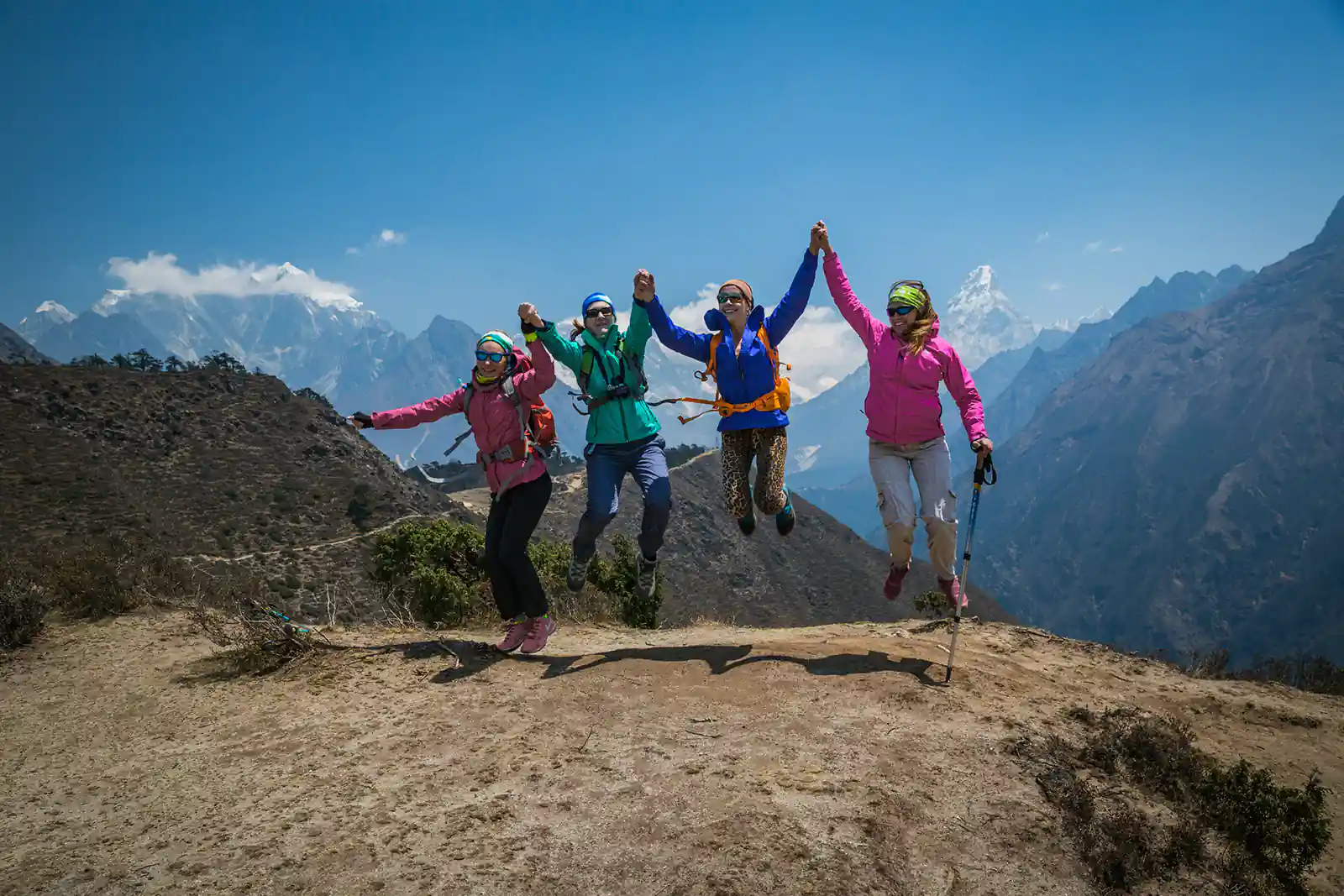
Experiencing the Everest Region in November
Breathtaking Scenery:
November in the Everest region offers a visual feast like no other. The snow-covered peaks of the Himalayas glisten in the clear, azure skies. Towering giants like Mount Everest, Lhotse, and Ama Dablam dominate the horizon, leaving trekkers in awe of their majestic presence. The landscapes transition from lush forests and meadows to rocky terrain, creating a diverse and constantly changing backdrop. As you ascend, you’ll witness the dramatic shifts in terrain and vegetation, a testament to the region’s incredible natural beauty.
Wildlife Encounters:
November also brings opportunities for wildlife enthusiasts. You may spot Himalayan tahr, musk deer, and pheasants along the trails. The skies are home to majestic Himalayan vultures and eagles. Keep an eye out for the elusive snow leopard tracks, too. These encounters add an exciting dimension to the trek, making every moment an adventure.
Cultural Experiences with Local Sherpas and Villages:
The Everest region is a visual wonderland and a cultural treasure trove. Engaging with the friendly and hospitable Sherpa people shows their distinctive lifestyle. Explore ancient monasteries such as Tengboche and Pangboche to observe time-honoured rituals and immerse yourself in a tranquil spiritual experience. The quaint villages along the way provide a glimpse into the daily lives of the locals, with their colourful prayer flags, ornate mani walls, and distinctive architecture. Sharing tea and stories with Sherpas in cosy teahouses is a heartwarming part of the journey, leaving lasting memories of the region’s rich culture.
In November, the Everest Base Camp Trek isn’t just about reaching a destination; it’s a holistic experience that combines breathtaking scenery, wildlife encounters, and cultural immersion. It’s a journey that connects you with the natural and human wonders of the Himalayas, leaving an indelible mark on your heart and soul.
Challenges and Tips for the Everest Base Camp Trek in November
Addressing Altitude Sickness:
Altitude sickness, a potentially severe concern during high-altitude treks like Everest Base Camp, requires attention. To prevent it, follow these tips:
– Gradual Ascent: Ascend slowly to allow your body to acclimatize. Follow recommended acclimatization schedules.
– Stay Hydrated: Drink plenty of fluids to combat dehydration, a common trigger for altitude sickness.
– Recognize Symptoms: Be aware of symptoms like headache, nausea, and dizziness. Descend if symptoms worsen.
– Medications: Carry altitude sickness medication (consult your doctor) and Diamox as a preventive measure if advised.
Difficulty of Trekking in Colder Weather:
November brings cooler temperatures to the Everest region. Be prepared by:
– Layering: Wear multiple layers to adapt to changing weather conditions.
– Warm Gear: Invest in quality insulated clothing, including down jackets and thermal wear.
– Footwear: Ensure warm, waterproof boots with proper insulation.
– Sleeping Bag: Bring a cold-rated bag for comfortable nights in teahouses.
– Hand and Foot Warmers: Pack disposable warmers for extremities.
Tips for a Safe and Enjoyable Journey:
– Local Guides: Hire experienced guides and porters who are familiar with the terrain and can assist in emergencies.
– Travel Insurance: Buy comprehensive travel insurance with high-altitude trekking coverage.
– Communication: Carry a satellite phone or a reliable emergency communication device.
– Pack Light: Travel light to reduce strain. Leave unnecessary items behind.
– Respect Local Culture: Embrace local customs and traditions, respecting the Sherpa culture.
– Stay Hygienic: Maintain good hygiene to prevent illnesses. Use hand sanitisers and purifying tablets.
By addressing altitude sickness, preparing for colder weather, and following safety tips, your Everest Base Camp Trek in November can be a rewarding and safe adventure. With the right precautions and mindset, you’ll be well-equipped to conquer the challenges and savour the breathtaking beauty of the Himalayas.
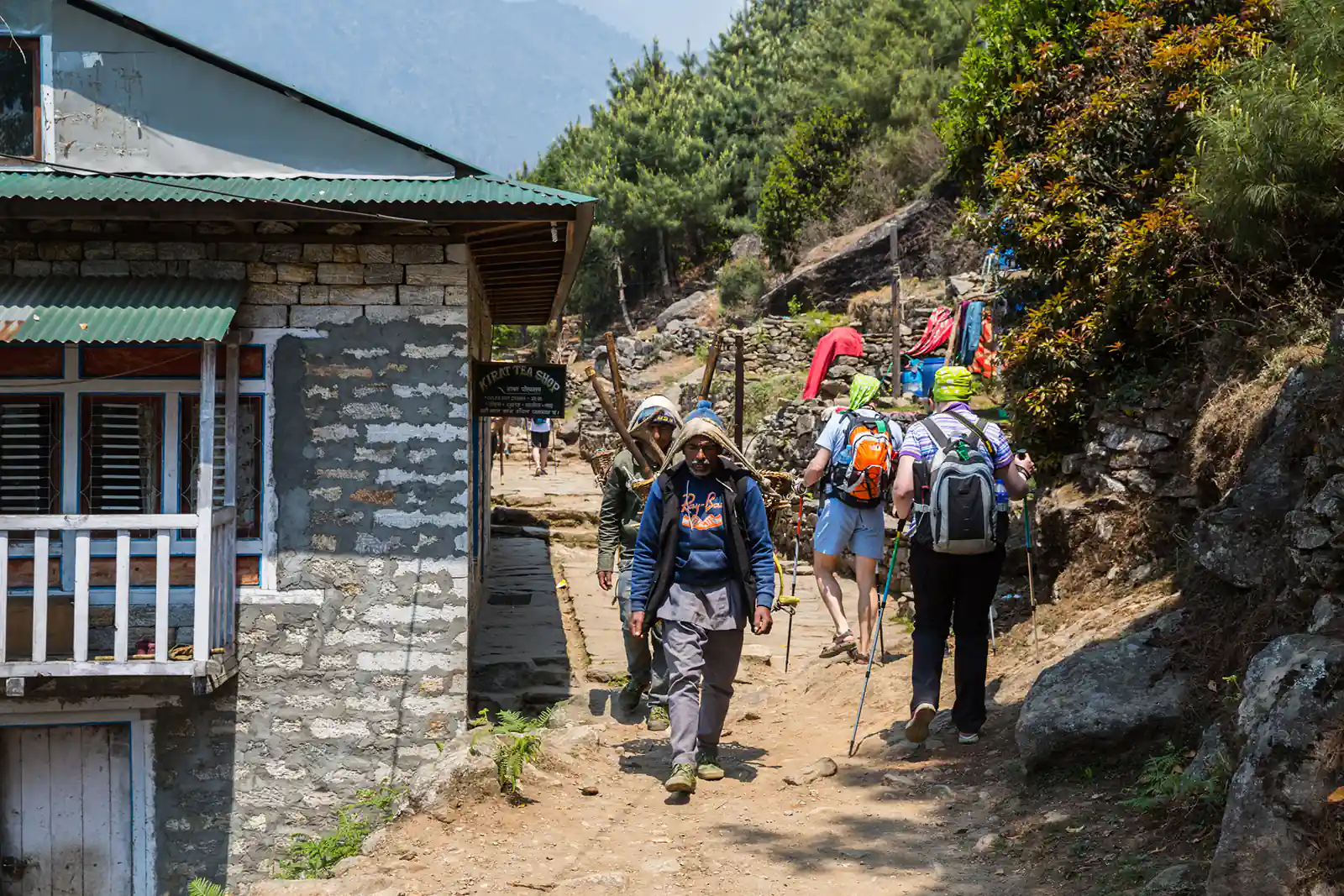
Accommodation and Food on the Everest Base Camp Trek in November
The Tea House Lodging System:
In the Everest region, the tea house lodging system is the primary accommodation option for trekkers. These are simple, family-run guesthouses along the trekking route. Tea houses provide basic amenities, including clean beds, blankets, and communal dining areas. While the facilities are not luxurious, they offer a cosy and authentic experience of Nepalese mountain hospitality. You’ll find tea houses at various points along the trail, making it easy to plan your daily stops.
Sample Menu Options and Dietary Considerations:
Tea houses typically serve a variety of dishes, including both local and international cuisine. Sample menu options include dal bhat (a traditional Nepali meal), pasta, soups, sandwiches, and pizza. Because of the remote location, people often prepare food with essential ingredients, but it remains hearty and satisfying. They can accommodate dietary considerations, including vegetarian, vegan, or gluten-free options, although choices may be limited at higher altitudes. It’s advisable to carry energy bars and snacks for extra sustenance.
Comfort and Amenities:
While tea houses offer a rustic experience, expect something other than luxury. Accommodations are basic, with shared bathrooms and often no heating. Blankets are provided, but bringing a good-quality sleeping bag is advisable, especially in November when temperatures drop at night. Charging electronic devices may incur an extra fee, and Wi-Fi can be slow or nonexistent in remote areas. Despite these limitations, tea houses provide a warm and welcoming atmosphere, and the communal dining areas often become social hubs where trekkers share stories and experiences.
The tea house lodging system along the Everest Base Camp Trek in November offers a genuine taste of mountain life. You’ll enjoy simple comforts, a range of food options, and the camaraderie of fellow trekkers. While it may lack luxury, the experience is rich in authenticity and unforgettable encounters with the local culture.
Everest Base Camp Short Trek
Everest Base Camp Trek
Everest Panorama Trek
Packing List for the Everest Base Camp Trek in November
Getting ready for the Everest Base Camp Trek in November requires thoughtful packing to guarantee both comfort and safety in the chilly conditions.
Clothing:
1. Insulated Jacket: A warm, insulated jacket to shield against freezing temperatures.
2. Layered Clothing: Thermal tops and bottoms for layering to regulate body heat.
3. Waterproof Shell: A waterproof and windproof shell jacket for protection against rain and snow.
4. Fleece Pullovers: Lightweight fleece layers for added warmth.
5. Trekking Pants: Quick-drying, moisture-wicking trekking pants.
6. Gloves and Mittens: Insulated gloves and mittens to keep hands warm.
7. Headwear: A warm beanie or hat and a neck gaiter or buff to protect against cold winds.
8. Socks: Woolen socks to keep feet warm and dry.
9. Hiking Boots: Sturdy, waterproof hiking boots with good ankle support.
10. Gaiters: Gaiters to prevent snow and debris from entering your boots.
Gear:
11. Backpack: A comfortable, well-fitted backpack with a rain cover.
12. Sleeping Bag: A cold-rated sleeping bag suitable for lower temperatures.
13. Trekking Poles: Lightweight trekking poles for stability on uneven terrain.
14. Headlamp: A dependable headlamp with additional batteries.
15. Sunglasses: Polarized sunglasses to protect against snow glare.
16. Water Purification: Water purification tablets or a filter.
17. Duffel Bag: A sturdy duffel bag for porters to carry your gear between tea houses.
Specific Items for Colder Weather:
18. Down Jacket: A high-quality down jacket for extreme cold.
19. Thermal Underwear: Extra thermal layers for added warmth.
20. Hand and Foot Warmers: Disposable warmers to combat cold extremities.
21. Hot Water Bottle: A hot water bottle in your sleeping bag for extra warmth.
When packing for the Everest Base Camp Trek in November, prioritize warmth and comfort. Layering is key to regulating body temperature ascending and descending through varying altitudes. With the proper clothing and gear, you’ll be well-prepared to tackle the chilly weather and thoroughly enjoy this remarkable adventure in the Himalayas.
Safety and Health on the Everest Base Camp Trek in November
Ensuring safety and health during the Everest Base Camp Trek in November is paramount. Here are essential guidelines to follow:
Emergency Protocols:
1. Altitude Sickness Awareness: Learn to recognize symptoms such as headache, nausea, and shortness of breath. If symptoms worsen, descend immediately.
2. Communication: Carry a satellite phone or a reliable communication device to call for help in emergencies.
3. Emergency Evacuation: Understand the evacuation procedures in case of severe altitude sickness or injuries. Know the locations of nearby medical facilities.
4. Stay with Your Group: Stick with your trekking group and guide to ensure safety in remote areas.
Importance of Travel Insurance:
Travel insurance is a non-negotiable necessity for the Everest Base Camp Trek in November. It provides crucial coverage for:
– Emergency Medical Expenses: Coverage for medical treatment and evacuation.
– Trip Cancellation: Reimbursement for trip cancellation or interruption.
– Baggage Loss: Compensation for lost or stolen luggage.
– Emergency Repatriation: Ensures your safe return home in severe cases.
Basic First-Aid Kit Checklist:
While trekking, carrying a well-equipped first-aid kit is essential. Your kit should include:
– Wound Care: Sterile gauze, adhesive bandages, antiseptic wipes, and adhesive tape.
– Medications: Pain relievers, anti-diarrheal medicine, antihistamines, and altitude sickness medication (if prescribed).
– Tools: Tweezers, scissors, and a thermometer.
– Personal Medications: Any prescription medications you require.
– Insect Repellent: Protection against insect bites.
– Blister Care: Moleskin or blister treatment patches.
– Sunscreen and Lip Balm: Protection from strong UV rays.
By following these safety and health guidelines, including emergency protocols, travel insurance, and a well-prepared first-aid kit, you’ll be better equipped to handle challenges during your Everest Base Camp Trek in November. Prioritizing safety ensures a smoother and more enjoyable journey in the stunning Himalayan landscape.
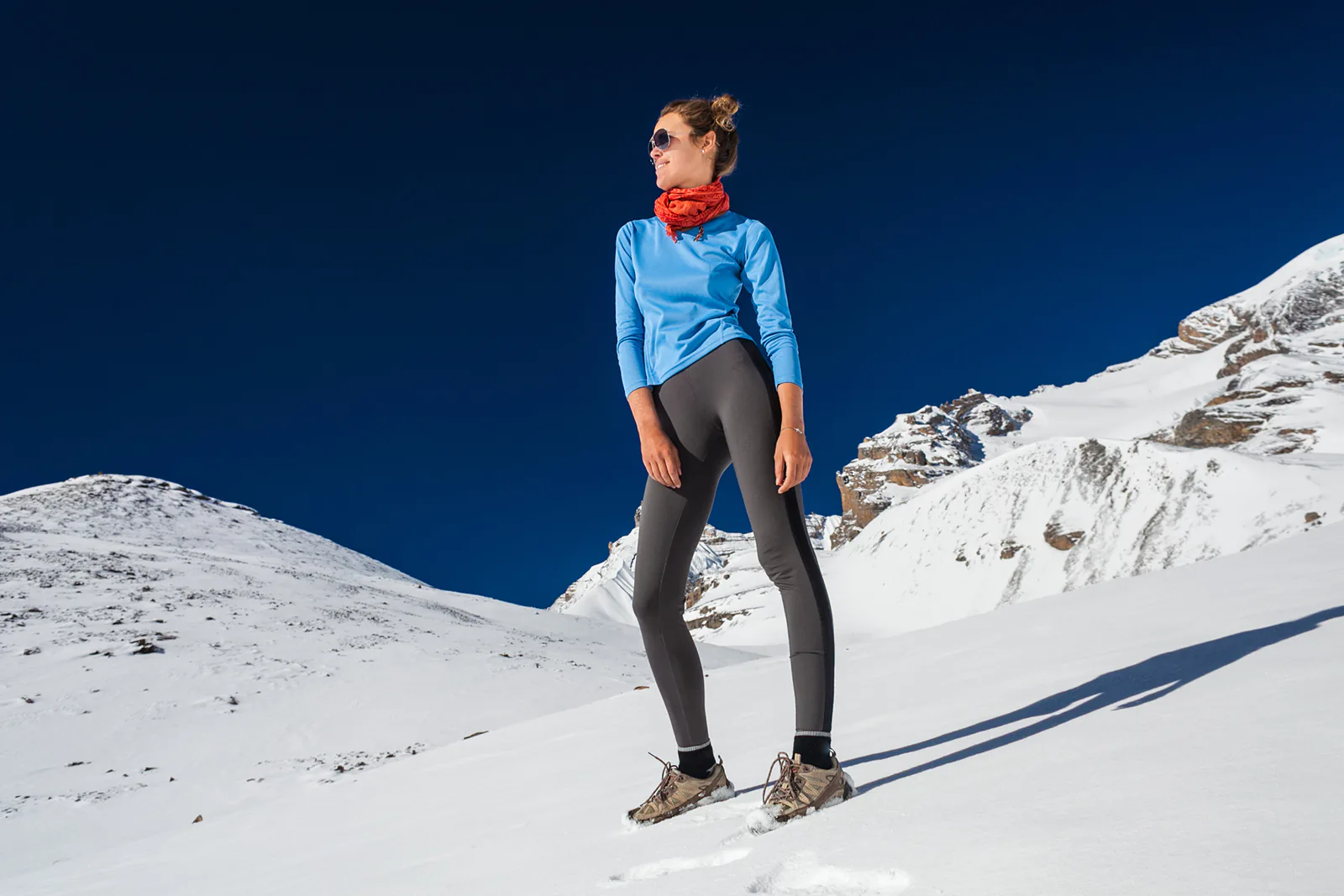
Permits and Regulations for the Everest Base Camp Trek in November
Everest Base Camp Trek in November, adhering to the necessary permits and regulations to protect the environment and ensure your safety is crucial.
Required Permits and Fees:
1. Sagarmatha National Park Entry Permit: This permit allows access to the Sagarmatha National Park, where much of the trekking route is located. The fee is typically around USD 25.
2. TIMS (Trekkers’ Information Management System) Card: The TIMS card is another essential permit that helps monitor trekkers’ movements. For individual trekkers, it costs approximately USD 20.
3. Local Tax: The local government collects a small amount from you. For individual trekkers, it costs approximately USD 18.
Please note that if you travel with Peregrine Treks, all fees are included in your package price.
Responsible Trekking Practices and Regulations:
1. Respect Local Culture: Be mindful of the Sherpa culture and customs. Always ask for permission before capturing photos of people or their belongings. Dress modestly, especially in villages and around religious sites.
2. Leave No Trace: Follow the ‘Leave No Trace’ principles by packing out all trash, not littering, and refraining from disturbing wildlife.
3. Stay on Designated Trails: Stick to established trekking routes and avoid creating new paths, which can damage fragile ecosystems.
4. Campfire and Fuel: Open fires are prohibited. Use gas stoves for cooking to minimize environmental impact.
5. Altitude Awareness: Ensure proper acclimatization to prevent altitude sickness. Respect and adhere to the recommended acclimatization days during your trek.
6. Travel with a Guide: While it’s not obligatory, we strongly advise hiring a local guide who is well-acquainted with the terrain, local customs, and emergency protocols.
7. Permit Regulations: Ensure you carry your permits and identification while trekking, as they may be checked at various checkpoints.
Responsible trekking practices and adherence to regulations not only protect the fragile mountain environment but also contribute to the preservation of the unique culture of the Sherpa people. When trekking in November, be a conscientious traveller, respecting nature and local communities to ensure a memorable and sustainable Everest Base Camp experience.
Costs and Budgeting for the Everest Base Camp Trek in November
When planning your Everest Base Camp trek in November, understanding the estimated costs and managing expenses wisely is crucial for a successful and affordable journey.
Estimated Costs:
1. Permits: The Sagarmatha National Park Entry Permit costs around USD 30, and the TIMS (Trekkers’ Information Management System) Card is approximately USD 20 for individual trekkers.
2. Flights: Round-trip flights from Kathmandu to Lukla typically range from USD 400 to USD 500, depending on availability and booking in advance.
3. Accommodation: Tea houses along the trek route charge roughly USD 10 to USD 30 per night, with lower prices at lower altitudes and slightly higher prices at higher altitudes.
4. Food: Meals can cost between USD 30 and USD 40 per day, depending on your choices and appetite.
5. Guides and Porters: Hiring a guide may cost around USD 30 to USD 40 per day, while porters charge approximately USD 25 to USD 35 per day.
Tips on Managing Expenses:
1. Travel in a Group: Sharing costs for accommodation, guides, and porters with a group can significantly reduce expenses.
2. Eat Locally: Opt for local dishes, which are often more affordable than international cuisines.
3. Refill Water: Carry a reusable water bottle and use purification tablets or filters to refill water, reducing the cost of bottled water.
4. Pack Light: Avoid excess baggage fees by packing only the essentials. Less weight also means lower porter fees.
5. Negotiate Prices: Avoid negotiating prices for accommodation and services, especially in the off-peak season like November.
6. Plan: Book your flights and accommodations in advance to secure better rates.
By carefully estimating your costs and following these tips, you can manage expenses effectively, ensuring that your Everest Base Camp trek in November remains within your budget while providing a rewarding and memorable experience in the stunning Himalayas.
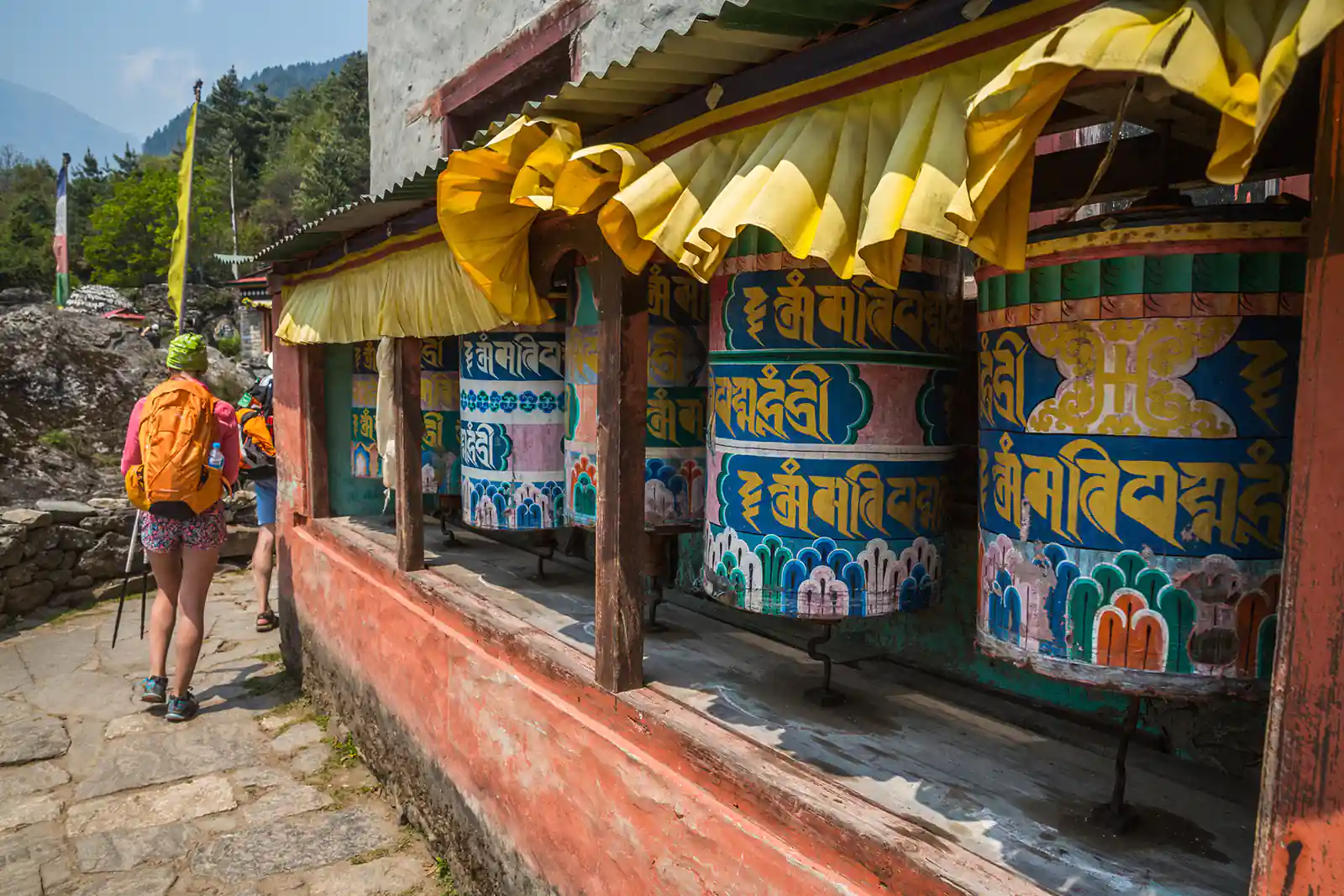
Conclusion: An Unforgettable Adventure in November
In November, the Everest Base Camp Trek offers a unique and captivating adventure in the heart of the Himalayas. As we conclude our exploration of this remarkable journey, let’s recap the advantages and extend an invitation to all aspiring trekkers.
Advantages of Trekking in November:
– Ideal Weather: November offers clear skies and moderate temperatures, reducing the risk of altitude sickness and providing breathtaking mountain views.
– Fewer Crowds: With fewer trekkers on the trail, you can enjoy a more serene and intimate experience of this majestic region.
– Cultural Richness: Interact with the warm Sherpa communities, witness their traditions, and visit ancient monasteries.
Everest Base Camp Trek in November is more than a physical adventure; it’s a soul-stirring journey that will leave an indelible mark on your heart. The stunning landscapes, the camaraderie of fellow trekkers, and the resilient spirit of the Sherpa people will inspire and uplift you.
I’ve been fortunate to witness the Himalayas’ majesty and the Nepalese culture’s warmth. It’s a journey that has enriched my life beyond measure, and I encourage you to seize this opportunity to create unforgettable memories.
So, lace up your hiking boots, prepare your bags, and set out on this incredible adventure—the Everest Base Camp Trek in November beckons, offering an experience you’ll treasure forever.

